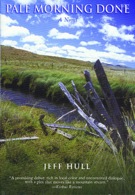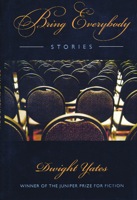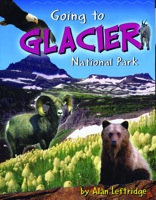Bookshelf
By Joyce Brusin The Boy Who Invented Skiing
The Boy Who Invented Skiing
by Swain Wolfe
New York: St. Martin’s Press, 2006, 287 pp., $24.95
Filmmaker and novelist Swain Wolfe begins and ends his memoir in tunnels. The first set wander beneath and entwine the buildings of the Colorado tuberculosis sanatorium where his father practiced medicine in the days before penicillin did away with such places. Wolfe ends his story, the first portion of his life, as a young copper miner working among the multitude of drifts tunneled beneath Butte’s richest hill. Both experiences helped shape him as an iconoclastic and frank purveyor of tales. He tells lovingly and unsentimentally of the horse that cheered and sustained his spirits in childhood, and later of the dreamers, bartenders, and hapless free spirits who provided “a sanctuary from cynicism, a place to bloom.”
The economic and spiritual deprivation of Wolfe’s youth unwittingly resulted in a resourceful and insightful soul, who originally took to reading in an outhouse to escape the nightly domestic disturbances of his ranch-bound mother and stepfather. Later, his own skills of observation and storytelling would build scaffolding strong enough to help him move from one life to another over and over again.
One of those moves finds him as a teenager in 1950s Missoula, acquainted with former UM professor and literary critic Leslie Fiedler and his son, and mentored by the owner of a newspaper and magazine stand who stocked Beat poets and novelists and existentialist philosophers along with his more predictable wares.
The boy who invented skiing invented himself as well. One winter day, while they were wandering home through the Colorado foothills of his boyhood, Wolfe’s smart and curious horse, Joe, stopped to look through the trusses of an old bridge. “In this cold-to-the-bone world, there was a tiny realm of color and motion in the frozen river. A warm spring fed into the river beneath the bridge, heating the water for a hundred feet downstream. It was the one place on the river that never froze. The open water attracted a colorful exhibition of swimming, diving, darting birds—fluorescent green ducks with yellow bills, golden-eyed ducks, water ouzels, cinnamon teals, and red-billed mergansers. We watched for several minutes before Joe remembered rolled oats. I could’ve watched for an hour, but I let him have his rein.”
 Pale Morning Done
Pale Morning Done
by Jeff Hull, M.F.A. ’95
Guilford, CT: The Lyons Press, 2005, 341 pp., $14.95
Thirty years after the publication of Norman Maclean’s A River Runs Through It, stories of fly fishing retain a sacred status in Montana. This often solitary sport, set in the wild country of rivers, continues to provide a luminous backdrop for stories of human nature, perhaps because reflection and introspection are nearly as important to it as the delicate tying and determined casting that come before. The deep pools, seasonal hatches, and flowing waters that define it are mingled here with an often raucous tale of fishing guides, their unrequited loves, conflicted loyalties, and determined stewardship of the places that make their lives possible.
River guide and landowner Marshall Tate is thirty-three years old and by his own account finds it absurd that he can’t say whether or not he’s in a committed relationship. For the past two years, his considerable energies have been given to the building and nurturing of a spring creek on his family’s sizable southwest Montana ranch. Loving toward animals, but somewhat obtuse with humans, including himself, he waits for the first spring and summer run of fishermen to crowd the banks of his stream and enrich his pockets. Before long, it becomes clear that intangibles like friendship, shared history, and the vast natural panorama that envelops him will prove far more valuable.
The title, a play on words, refers to a mid-summer hatch of pale morning duns that Tate’s sometime lover, friend, and fellow guide Molly Huckabee encounters one afternoon on the Clark Fork River just above Superior: “At about one o’clock in the afternoon a cloud front that had been assembling in ragged wisps over the mountains set adrift across the sky and screened the sun. The river’s surface darkened, a bit of sprinkle began, the vegetation along the bank seemed to swell and green, and then the PMDs appeared. Across the glossy blue-brown surface of the Clark Fork, dipping and turning on bulges and swells, yellow bugs with their wings folded upright like lavender sails littered the river. The insects seemed to burst forth from just below the surface, the emergence so profligate and vast that Molly thought there should be sound effects…. Fish broke the surface across the entire river, rising in places where fish had no business being.”
 The Inhabited World
The Inhabited World
by David Long, M.A. ’74
New York: Houghton Mifflin Company, 2006, 277 pp., $23.00
Evan Molloy, the protagonist of The Inhabited World, inhabited his life and his body less and less, until finally, in mid-life, as his second marriage was unraveling, he committed suicide. He awakes afterwards, as though from a deep sleep, to find his spirit still wanders the rooms of the Seattle house where he lived, able to observe the new living tenants around him, but unable to leave or to articulate what went wrong.
David Long’s fourth novel depicts the return of Evan’s memories and his struggles to understand why he took his own life. Evan first recalls his struggles with a charismatic and successful father, Donovan, who, after his discharge from the Navy, had become one of Seattle’s leading designers and fabricators of “massive iron gates, fences, and sculptural, and architectural pieces.” After college, Evan becomes a consultant, good at advising those like his father who are determined to strike out on their own. Keenly aware of their differences all his life, Evan in death comes around to a different perspective:
“Suddenly he wonders why it had been so important to resist Donovan all that time, and just as suddenly he’s buffeted by love for his father. He’d always blamed Donovan for setting an impossible example, always taken him for one of those overbearing patriarchal types.
But so what if Donovan had stamina to burn, so what if he wasn’t crippled by the usual qualms and frailties? He was also gifted, ethical, not stingy with his time, and nowhere near as judgmental of Evan as Evan had given him credit for being…. No, Evan had given his father a bum rap.”
He recalls his cynical sister, his loving wife, and a troubled thirteen-year-old step-daughter, who fell into a darkly tangled coming-of-age just prior to Evan’s own swift descent. As he remembers more of the past, he observes what is now his present: watching the struggles of the living to correct what they can.
A woman in her thirties, alone after a long illicit affair, lives in Evan’s old house, where she has come to re-establish her life. Evan watches her with the fascination of a lover, recalling the marriages he held dear but seemed fated to squander. Unable to change the trajectory his life took, he waits expectantly for the woman to grow into her new life and for himself to finally be free of the life he never fully owned.
 Bring Everybody
Bring Everybody
by Dwight Yates, M.A. ’70
Amherst and Boston: University of Massachusetts Press, 2006, 143 pp., $24.95
The characters in these thirteen stories sometimes contribute to their own demise, but none of them falls short when it comes to an honest effort to do otherwise. Largely domestic in setting, these short sketches explore the lives of mapmakers, school bus drivers, postal carriers, accountants, a Beckett scholar, and assorted others who wake each day in the deserts, mountains, and beaches of southern California, between Los Angeles and San Diego, stretched along what one character calls “one long surfing opportunity.” The author, a professor of creative writing at the University of California, Riverside, pays equal heed to plot, character, and the craft of language to create endearingly corrupted characters, several of whom teach or work at colleges, all of whom are confronting their own limitations. Impulses backfire. A cartographer at a professional conference inadvertently hooks up with a woman from his past, a hydrologist who never quite got over him. A young, pregnant wife from Omaha finds herself living among strangers—her new husband’s friends and family—in the Marine-base-town of Oceanside. In “Gisela,” a middle-aged art historian puts his academic scholarship to memorable use when confronting the twenty-nine-year-old investment adviser his wife of twenty years has found irresistible. Whatever impasse these stories come to, they are carried along by humor, pathos, and a lovingly engineered buoyancy.
Book Briefs
 High-mountain Two-manner
High-mountain Two-manner
By Frank Fowler ’54
Xlibris, 2006, 278 pp., $21.95
The author draws from letters he wrote to his mother as a young man and the memories of other smokejumpers to create an engaging memoir of the early days of smokejumping in Montana. Moving from Washington, DC, to Missoula in the early 1950s to attend UM’s School of Forestry, Fowler found the adventure he was seeking—in school, in his work for the Forest Service, and in summer jobs, including a stint at Fort Keough in eastern Montana.
 Waking Lazarus
Waking Lazarus
by T. L. Hines ’90
Bloomington, MN: Bethany House, 2006, 235 pp., $18.99
Red Lodge is the setting for this Christian-themed mystery novel that tells how a local man, who has died and mysteriously come back to life three times, now must help absolve himself from suspicion when children around him begin to disappear.
 Wings Over Montana
Wings Over Montana
Photography by Donald M. Jones ’85
Helena: Far Country Press, 2006, 127 pp., $24.95
Getting a close look at our feathered friends is always a challenge, so this nicely produced coffee table book is a welcome addition to avian viewing. Jones has spent two decades photographing wildlife and these photos show it. They are brilliant, stunning, educational, and entertaining. Daniel Casey contributed the introduction and narrative.
 Going to Glacier National Park
Going to Glacier National Park
By Alan Leftridge
Helena: Far Country Press, 2006, 48 pp., $12.95
You’ll learn new and unexpected things when you pick up this colorful and fun book aimed at children, but educational for adults as well. For instance: from a vantage point in the park you can see Triple Divide Peak, the only place in the United States where water flows to three oceans—to the Pacific through the Columbia River, the Atlantic through the Mississippi, and the Arctic through Hudson Bay. The author touches on the history of the park, its many animal, plant, and insect species, and provides ideas for day hikes.